AI Develops Technology to Predict Breast Cancer Outbreak

by
MIT Computer Science and Artificial Intelligence Research Institute announced that deep learning has developed a method to predict the occurrence of breast cancer. In addition to being able to detect people who are prone to breast cancer with much higher accuracy than before, this is expected to help early detection of cancers other than breast cancer and myocardial infarction.
A Deep Learning Mammography-based Model for Improved Breast Cancer Risk Prediction | Radiology
https://pubs.rsna.org/doi/10.1148/radiol.2019182716
MIT CSAIL's AI can predict the onset of breast cancer 5 years in advance | VentureBeat
https://venturebeat.com/20019/05/07/mit-csails-ai-can-predict-the-onset-of-breast-cancer-5-years-in-advance/
In the United States, breast cancer is the second leading cause of cancer-related deaths, and approximately 232,000 people are diagnosed with breast cancer in 2015 alone, and approximately 40,000 people die from breast cancer. There are also findings that among the cancer patients in the world, the number of breast cancer patients is the highest. For this reason, research to detect breast cancer at an early stage around the world is actively conducted, and in recent cases it was announced that Google's AI was able to detect metastatic breast cancer with an accuracy of 99%.
Google's AI can detect metastatic breast cancer with 99% accuracy

It is, of course, important to detect cancer that has already occurred at an early stage, but if you know in advance whether cancer will occur in the future, it will be more effective through close cancer tests etc. Can be prevented and treated. Therefore, in order to predict the occurrence of breast cancer, methods such as the 'Tyrer-Cuzick (TC) method' have been used so far, which predict the occurrence of cancer statistically from the density of breast glands and cancer history of the family. However, the accuracy was not necessarily high.
Therefore, we have developed a method that can predict the occurrence of breast cancer with high accuracy by deep learning, such as the research group of Regina Vergelay and others who are studying AI at the MIT Computer Science and Artificial Intelligence Research Institute. The research group used AI to deep learning by using 89,994 images taken by mammography for 39,571 women and statistical data on cancer diagnosis status for 5 years after the test. I was trained.
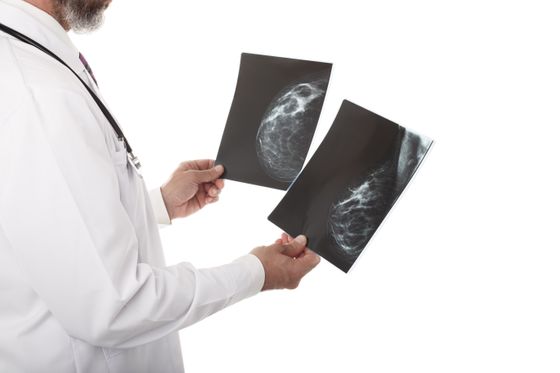
by Lana_M
After that, the image of the mammography examination for 68,868 people and the statistical data of the diagnosis situation are 'conventional TC method' 'Diagnostic (DL) method by deep learning' 'hybrid DL method combining TC method and DL method' We analyzed each of the three methods to verify breast cancer prediction accuracy. As a result, the DL method and the hybrid DL method using deep learning were able to predict the occurrence of breast cancer with high accuracy compared to the TC method only that has been conventionally used to predict breast cancer.
The following image is a comparison of the risk assessment by the conventional TC method and the hybrid DL method and the actual cancer incidence rate. Risk assessment is in three stages of 'low, medium and high', with the vertical axis from the top 'low, medium and high risk of TC method' and the horizontal axis from the left, 'low, medium and high risk from hybrid DL method' Represents
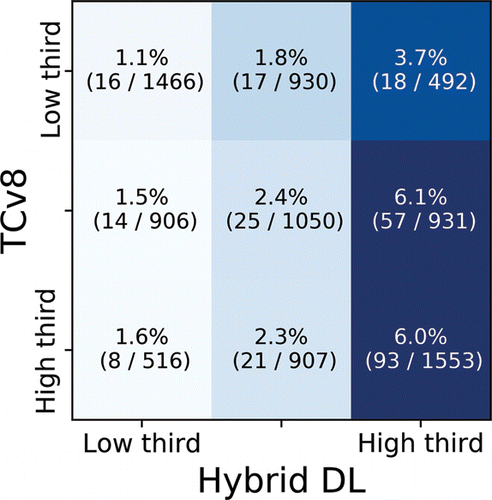
For example, the top left is a group that both TC method and hybrid DL method were evaluated as low risk, and only 16 out of 1466 people actually had cancer, only 1.1%.

And the upper right is the group that TC method was evaluated as low risk, while the hybrid DL method was evaluated as high risk. Although the TC method was evaluated as low risk, the actual cancer incidence rate was never as low as 3.7%, so the hybrid DL method more accurately predicts cancer than the TC method. I understand that

In addition, the hybrid DL method showed higher accuracy compared to the evaluation based on the density of the mammary gland that the TC method is a key to prediction. The image below compares the high and low breast density with the risk assessment of the hybrid DL method. Above the vertical axis is the cancer incidence rate in the low breast density group and in the lower group, and the left side of the horizontal axis is the group evaluated as low risk by the hybrid DL method, and the right side is the group evaluated as high risk Is represented.

Those who rated the hybrid DL method as low risk had the same cancer rate of 1.4% regardless of breast density ...
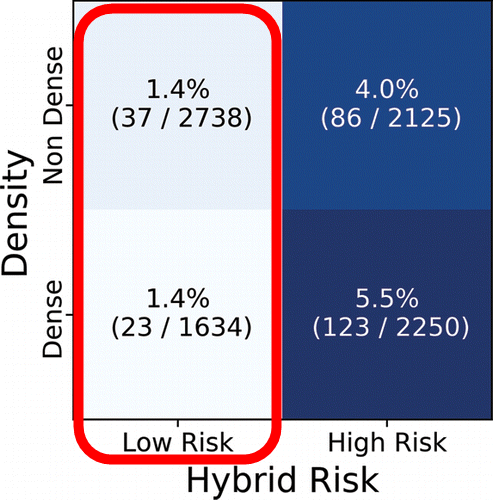
Among those who evaluated the hybrid DL method as having high risk, 4% of people with low breast density and 5.5% of people with high breast density were diagnosed with breast cancer. Because breast cancer occurs with a slightly higher probability in people with high breast density, risk assessment at breast density is not necessarily meaningless, but its accuracy is considerably lower than the method developed by MIT this time It can be said.

The following images compare the above two figures with the actual mammography images classified into each group of the figures. The fact that it is indistinguishable to the human eye shows that it is difficult for even skilled radiologists to determine whether breast cancer will occur in the future from mammography.
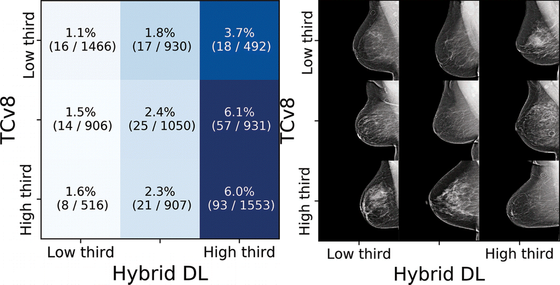
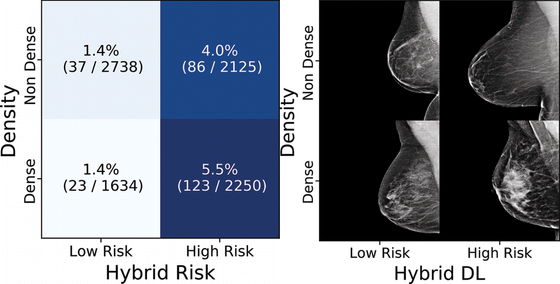
According to the conventional prediction method using the TC method, the accuracy of breast cancer incidence was 18%, while the method using deep learning was able to predict the occurrence of breast cancer with an accuracy as high as 31%. . 'The method is the basis for predicting health problems other than breast cancer,' Vergey Ray of the research group told technology news media VentureBeat , saying that it is a myocardial infarction and other types of He indicated that it could be applied to cancer and so on.
Related Posts:
in Science, Posted by log1l_ks







